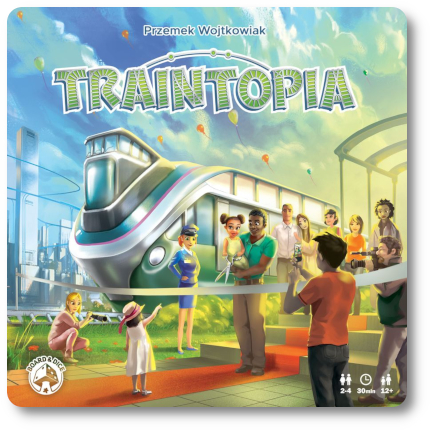
The Basics:
- For ages 10 and up (publisher suggests 12+)
- For 2 to 4 players
- Approximately 30 minutes to complete
Geek Skills:
- Active Listening & Communication
- Counting & Math
- Logical & Critical Decision Making
- Pattern/Color Matching
- Strategy & Tactics
- Risk vs. Reward
- Visuospatial Skills
- Hand/Resource Management
- Worker Placement & Area Control
Learning Curve:
- Child – Easy
- Adult – Easy
Theme & Narrative:
- Build a productive network of stations and tracks for the win
Endorsements:
- Gamer Geek approved!
- Parent Geek approved!
- Child Geek approved!
Overview
Co-founder of Pixar and president of Walt Disney Animation Studios, Edwin Catmull, said, “Driving the train doesn’t set its course. The real job is laying the track.” In this game, players take on the responsibility of doing just that. They will build an extensive network of rails, stations, and sites to see along the way. The goal is to connect, but more importantly, connect with a purpose and to provide value. A lesson we can all benefit from, both at and away from the gaming table.
Traintopia, designed by Przemek Wojtkowiak and published by Board&Dice, is comprised of 15 Commuter meeples, ten Tourist meeples, one Railway Inspector meeple, five Train meeples, six Mailbag meeples, 50 Map tiles, 10 bonus tiles, four Starting tiles, one Railhead tile, 24 Money tokens, 90 victory points (in the values of one, three, ten, and 50), eight Objective cards, nine Round cards, one End Game Bonus car, and four Player Aid cards. The meeples are all made of wood, and the tiles and tokens are made of thick cardboard. The cards are as thick and as durable as your standard playing card.
All Aboard!
Note: Traintopia is a tile-laying game, which means, for those of you who have not played many games like this, you will need a lot of table space. I suggest you use a big family dining table, as both nature and train track building games abhor a vacuum. Do expect to test the limits of your table boundaries.
To set up the game, first shuffle the 50 Map tiles and place them in several stacks. The stacks need not be of equal value. If you have one around, I strongly suggest you put them in a cloth bag. Much easier to manage and to play with. Also, at this time, place all the Commuter meeples in the supplied cloth bag. This is the “Commuter” bag.
Second, place the bonus tiles in a face-up line off to one side of the game playing area.
Third, shuffle the Round cards and place them in a stack, face-down, next to the bonus tiles. This is the Round draw deck for the duration of the game. Depending on the number of players in the game, you will now draw and remove from the Round draw deck a number of cards, returning them to the game box.
Fourth, place the End Game Bonus card face-up next to the Round deck. On this card, put the Railway Inspector meeple, the Railhead tile, one Trian meeple, and one Mailbag meeple.
Fifth, shuffle the Objective cards and deal one to each player, face-down. Players should look at their Objective card, but keep them hidden from their opponents. Place the remaining Objective cards face-down to create the Objective draw deck.
Sixth, take the Player Aid cards and set aside one per player, making sure that one of the Player Aid cards selected has the “Conductor” symbol. Any Player Aid cards not selected are placed back in the game box. Shuffle the Player Aid cards and deal one to each player. The player who has the “Conductor” symbol found on the Player Aid card is the lead player.
Seventh, place the money tokens, victory point tokens, Tourist meeples, Train meeples, and Mailbag meeples into small piles off to the side of the game playing area.
Eighth, deal to each player one Starting tile at random. These are placed face-up in front of the owning player now and is the starting point for all the tiles to be placed during the game. Any Starting tiles not used should be returned to the game box at this time.
Ninth, reveal a number of Map tiles equal to the number of players in the game, times two. For example, if playing with four players, you’d reveal eight. Place these tiles in the middle of the table, face-up, in rows and columns (whatever works best for your tablespace).
Tenth, beginning with the last player and continuing in reverse turn order sequence, each player now selects one Map tile. After the starting player selects their first tile, they select their second tile and every player now selects their second tile in the normal turn order sequence. All players now add their selected Map tiles to their starting tile. This is the player’s “network.”
That’s it for the game set up. The player who has the “Conductor” symbol found on the Player Aid card is the lead player. Hand them the cloth bag full of the Commuter meeples and begin!
Keeping to the Schedule
Traintopia is played in rounds with no set number of rounds per game. A round of gameplay is summarized here.
Step One: Preparation
The lead player draws one Round card and places it face-up where all players can easily see it. The Round card will display the number of meeples and tiles that will come into play this round. This will require placing single meeples of a specific type, randomly drawing meeples, and randomly drawing Map tiles.
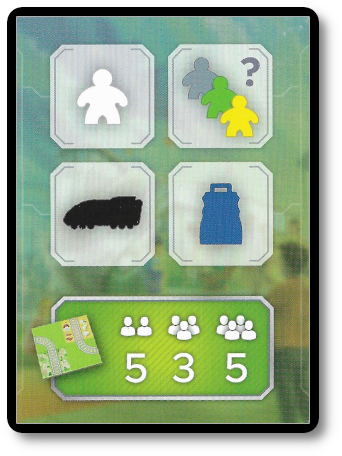
Step Two: Draft
Starting with the lead player, and proceeding in normal turn order sequence, each player will select one tile or meeple from the Round card. Once the tile or meeple is selected, it’s immediately placed. After the selected tile or meeple is placed, it’s the next player’s turn in turn order sequence to select. This continues until only one meeple or tile is remaining. No one will claim this item.
When placing a tile, players must follow a few simple rules. Collected Map tiles may be rotated in any direction, and when placed to Map tiles on the table, at least half of one side must be touching. This means tiles will be either fully adjacent to another or only half of it will be adjacent. Map tiles can never overlap another Map tile.
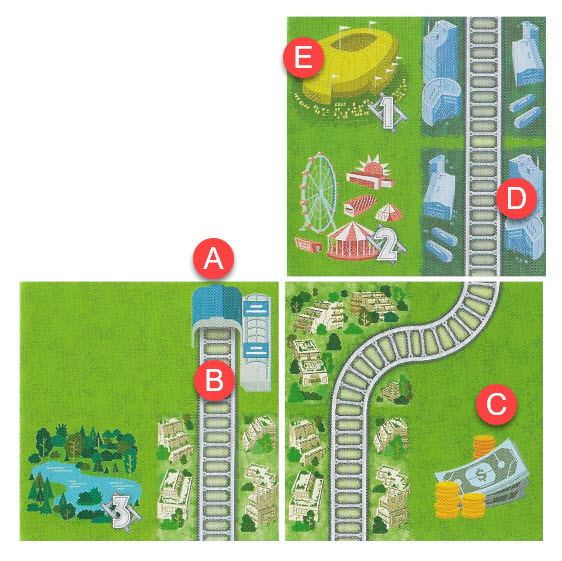
A) Station (blue)
B) Track
C) Money icon
D) District (grey)
E) Landmark
Tracks do not have to match to the Map tiles they are placed next to. You cannot, however, place a tile so any part of the track is now a dead-end. A dead-end is considered a track on one tile not connecting to another track on a previously placed Map tile if the tiles are connected. In addition, placing a Map tile with a track cannot create an infinite loop. All tracks must start or stop in an empty space (i.e. not connecting to another tile) or Station.
If the Map tile placed has a money icon, a Money token is added to each icon once the Map tile is placed. Here the tokens will remain until the player wants to spend them. At any time during the player’s turn (before and after drafting), they may remove one Money token (returning them to the pile) to “pay” for one of the following actions, but can pay no more than three and cannot take any of the following actions more than once:
- Purchase a bonus tile: select any face-up Bonus tile and add it to the player’s network.
- Change commuter color: regardless of the Commuter meeple color drafted and any previously placed Commuter meeples, the player can announce it’s new temporary color and score it accordingly.
- Gain an objective: draw one Objective card and decide to keep (placing your previously Objective card to the bottom of the Objective draw deck) or discard it to the game box.
Commuter meeples are placed to the track on the previously placed Map tiles. Once placed, the player counts one victory point for each district that the track runs through that matches the Commuter meeple color. The only limitation when placing a Commuter meeple to a track is that only one Commuter of that color type can be associated with that track line. For example, if the track you are placing the Commuter meeple to already has a Commuter meeple of the same color attached, you’ll have to find a different track.
Tourist meeples are placed on any track that does not already have a Tourist meeple. The player then scores the victory points noted on the Landmark that is adjacent to the track the Tourist meeple is associated with. This includes bends in the track that would place the Landmark diagonally to the track itself. Landmarks need not be on the same Map tile to be scored, just adjacent to the track the Tourist meeple is attached to.
Mailbag and Train meeples, like the Commuter and Tourist meeples, can only ever be associated with one track, and only one of each type is allowed. When placed, the player takes no further action. Train and Mailbag meeples are used for scoring at the end of the game.
If a player is unable to place any of the items they drafted, they are not stuck. Instead of placing them, they are returned to the game box, and the player collects one victory point.
Step Three: Clean-Up
When only one item remains, place it and the Round card into the game box and out of the game.
If there are any cards left in the Round draw deck, the Commuter bag is handed to the next player in turn order sequence, making them the next round’s lead player.
Arriving at the Station
The endgame is triggered once there are no more Round cards to draw during the round’s clean-up step. All players now resolve their Bonus card. To do so, all players add the victory points they have earned so far. The player with the fewest now selects one of the elements found on the final Bonus card to score. Elements include the following:
- Railhead: The player takes the tile and places it to their network, attaching it to any unfinished track.
- Railway Inspector: This special meeple is added to any track owned by the player. The player then announces one district color (yellow, green, or grey). It’s scored the same way as a Commuter.
- Mailbag and Trains: These work just like the meeples of the same type. They are placed on the player’s network using the same rules.
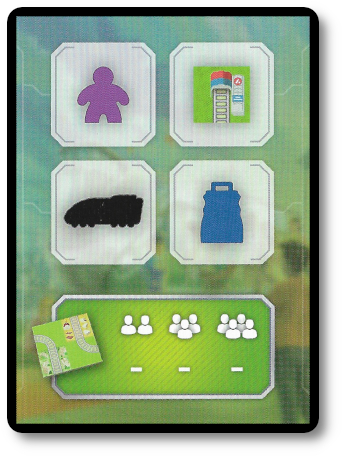
After the player with the fewest victory points selects and uses an element, the player with the next fewest selects and so on until all players have had a chance to select an element from whatever might be left on the Bonus card.
Each player now looks at their network and scores points as follows:
- For each finished track (where “finished” means it has a station at both ends), the player counts the length by counting how many tiles the track crosses (each tile is only counted once). Depending on the length, the player scores additional victory points, with even more being scored if the station colors are different. If there is a Mailbag meeple on the finished track, the player scores double the earned victory points!
- For each Train meeple on a track that also has an adjacent unclaimed Money token, the player earns several victory points (each Money token can only be counted once if two or more Train meeples are adjacent to it).
- The player with the longest track (that does not have to be finished) earns additional victory points.
Finally, if players have completed their Objective card, they are scored at this time. There is no penalty if the objective is not met.
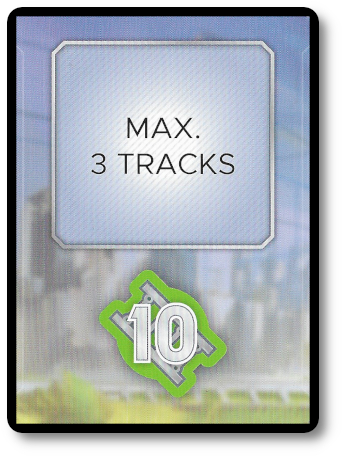
To learn more about Traintopia, visit the game’s web page.
Final Word
 The Child Geeks enjoyed themselves immensely. The game has a good deal of “table appeal,” which is a fancy way of saying, “it looks cool.” There is something about building something that is uniquely your own and getting immediate feedback from the game itself and others that just feels right. According to one Child Geek, “The game can feel a bit too big at times when you have so many choices, but if you think about what you want to do each turn – even when it isn’t your turn – the game becomes pretty easy.” Easy as in choices to make, but not to win, as was observed by our next Child Geek, who said, “The best part of this game is watching how other players build their tracks and taking ideas from what you see to make your track better. It is a hard game to win when everyone can see how well you are doing!” Well said, and well-received! All the Child Geeks voted to approve Traintopia.
The Child Geeks enjoyed themselves immensely. The game has a good deal of “table appeal,” which is a fancy way of saying, “it looks cool.” There is something about building something that is uniquely your own and getting immediate feedback from the game itself and others that just feels right. According to one Child Geek, “The game can feel a bit too big at times when you have so many choices, but if you think about what you want to do each turn – even when it isn’t your turn – the game becomes pretty easy.” Easy as in choices to make, but not to win, as was observed by our next Child Geek, who said, “The best part of this game is watching how other players build their tracks and taking ideas from what you see to make your track better. It is a hard game to win when everyone can see how well you are doing!” Well said, and well-received! All the Child Geeks voted to approve Traintopia.
 The Parent Geeks also found it to be a great game. In the time of COVID, getting together with other parents is difficult. Finding games that are just as engaging for the adults as it is for the kids is not easy. No such difficulty was found here! According to one Parent Geek, “This game was enjoyed by all! It is easy enough to teach and in-depth enough to keep both the kids and the parents thinking. No brain pain, but a great exercise in creative thinking and problem-solving!” Another Parent Geek said, “Really enjoyed it. Great fun trying to make the perfect railroad with all the best stops. My only complaint is that my family didn’t want to play it more while we had it at our table.” When the last train came into the Station, the Parent Geeks gave Traintopia two thumbs straight up.
The Parent Geeks also found it to be a great game. In the time of COVID, getting together with other parents is difficult. Finding games that are just as engaging for the adults as it is for the kids is not easy. No such difficulty was found here! According to one Parent Geek, “This game was enjoyed by all! It is easy enough to teach and in-depth enough to keep both the kids and the parents thinking. No brain pain, but a great exercise in creative thinking and problem-solving!” Another Parent Geek said, “Really enjoyed it. Great fun trying to make the perfect railroad with all the best stops. My only complaint is that my family didn’t want to play it more while we had it at our table.” When the last train came into the Station, the Parent Geeks gave Traintopia two thumbs straight up.
 The Gamer Geeks found Traintopia to be entertaining, but not altogether their speed. According to one Gamer Geek, “The game is well designed, is challenging, and entertained me while I played it. I would have liked to have seen more players interaction, but I don’t know how well that would work anyway. I’d play it again.” Another Gamer Geek said, “Solid and performed well. Kept us talking and playing. Great stuff with a beer or two, as well. I would recommend this game as a filler or for gamer nights where a lighter game is requested.” After traveling around the tracks, making its way from one gamer geek’s table to the next, the game returned to me. In the box were the votes from our elitist, and they were all positive, resulting in Traintopia getting the approval from our Gamer Geeks.
The Gamer Geeks found Traintopia to be entertaining, but not altogether their speed. According to one Gamer Geek, “The game is well designed, is challenging, and entertained me while I played it. I would have liked to have seen more players interaction, but I don’t know how well that would work anyway. I’d play it again.” Another Gamer Geek said, “Solid and performed well. Kept us talking and playing. Great stuff with a beer or two, as well. I would recommend this game as a filler or for gamer nights where a lighter game is requested.” After traveling around the tracks, making its way from one gamer geek’s table to the next, the game returned to me. In the box were the votes from our elitist, and they were all positive, resulting in Traintopia getting the approval from our Gamer Geeks.
 Make no mistake; this is a light game. Yes, there is a good deal of thinking involved and planning, but since there is no player interaction (other than the drafting element), it’s entirely focused on the player’s choices alone. This should not be considered a negative strike against the game by any means, but I do want to bring it up as many of our players likened it to Carcassonne, which Traintopia is undoubtedly not. In Carcassonne, the players are building the board and competing on the same stage. The big difference here is that each player in Traintopia has their own stage. This makes the game less intense from a competitive standpoint, but no less difficult to win. Since players do not have any involvement with their opponents’ tracks, they must observe and out-build. That is a challenge in and of itself!
Make no mistake; this is a light game. Yes, there is a good deal of thinking involved and planning, but since there is no player interaction (other than the drafting element), it’s entirely focused on the player’s choices alone. This should not be considered a negative strike against the game by any means, but I do want to bring it up as many of our players likened it to Carcassonne, which Traintopia is undoubtedly not. In Carcassonne, the players are building the board and competing on the same stage. The big difference here is that each player in Traintopia has their own stage. This makes the game less intense from a competitive standpoint, but no less difficult to win. Since players do not have any involvement with their opponents’ tracks, they must observe and out-build. That is a challenge in and of itself!
I have heard it said many times that Traintopia is a “family game,” which is true. It certainly worked well for our Child Geeks and Parents Geeks. It’s also a game that has enough strategy and tactics for our Gamer Geeks, as well. While they did find Traintopia to be lighter than their regular “go-to” games, they all agreed there was enough decision making that required strategic thinking and tactical action to keep them hooked. Plus, with a runtime of less than an hour, it meant games were intense and involved, but never felt too long.
Downtime in the game didn’t distract from its enjoyment. What little downtime there was provided players out-of-turn an opportunity to observe, comment, and even cooperate with tile placement. Since everyone is running their own race, there is little harm in providing your opponent a helpful comment, to a point. There is, after all, only one winner of the game. However, by helping others think through the tile, token, and meeple placement, it kept the game going, avoiding the unfortunate behavior seen often when a player becomes overwhelmed with choices and freezes.
I am most pleased with Traintopia. It kept us all involved and is highly replayable. No one game was ever the same, but nor did our players ever feel like they had to reset their own understanding of the game, either. The simple rules, endless possible ways to build your tracks, and the random draws kept players engaged and leaning forward. Great stuff.
If you like games with thematic elements of trains and enjoy a challenge of building networks that complement each other, do sit down for a game or three of Traintopia. Get on board and see if you enjoy the ride!
This game was given to Father Geek as a review copy. Father Geek was not paid, bribed, wined, dined, or threatened in vain hopes of influencing this review. Such is the statuesque and legendary integrity of Father Geek.



